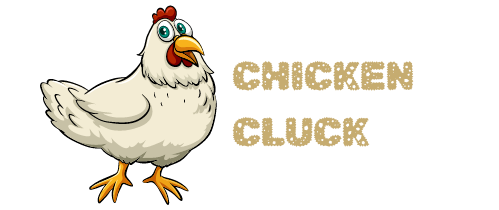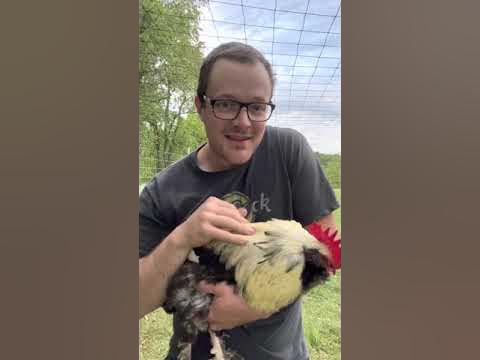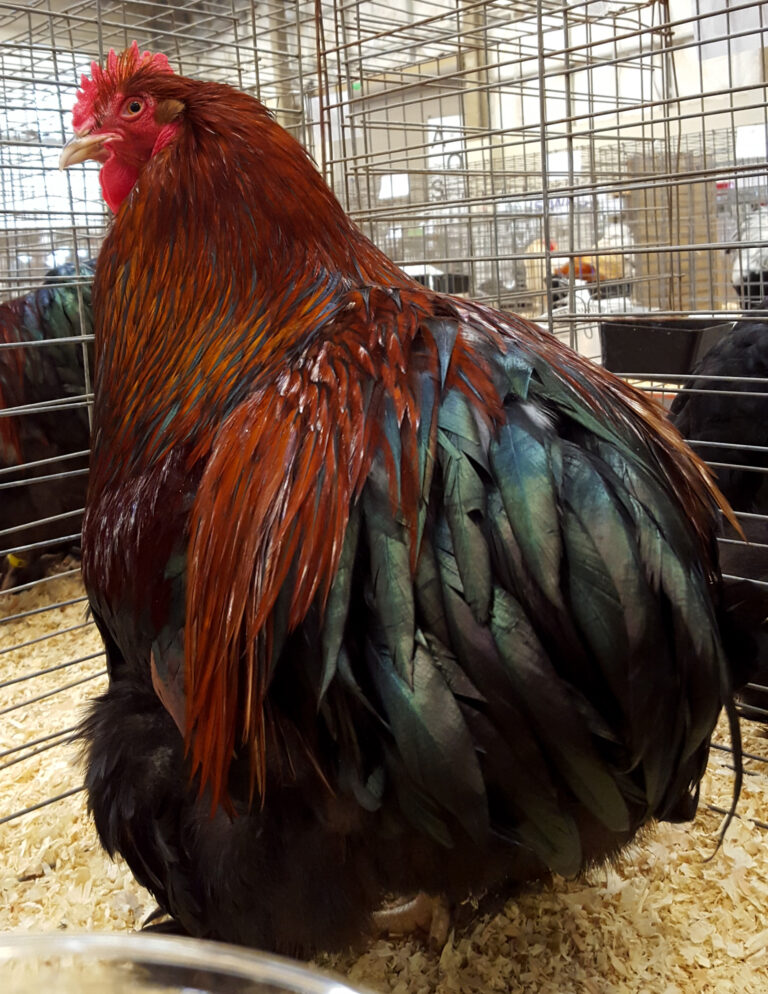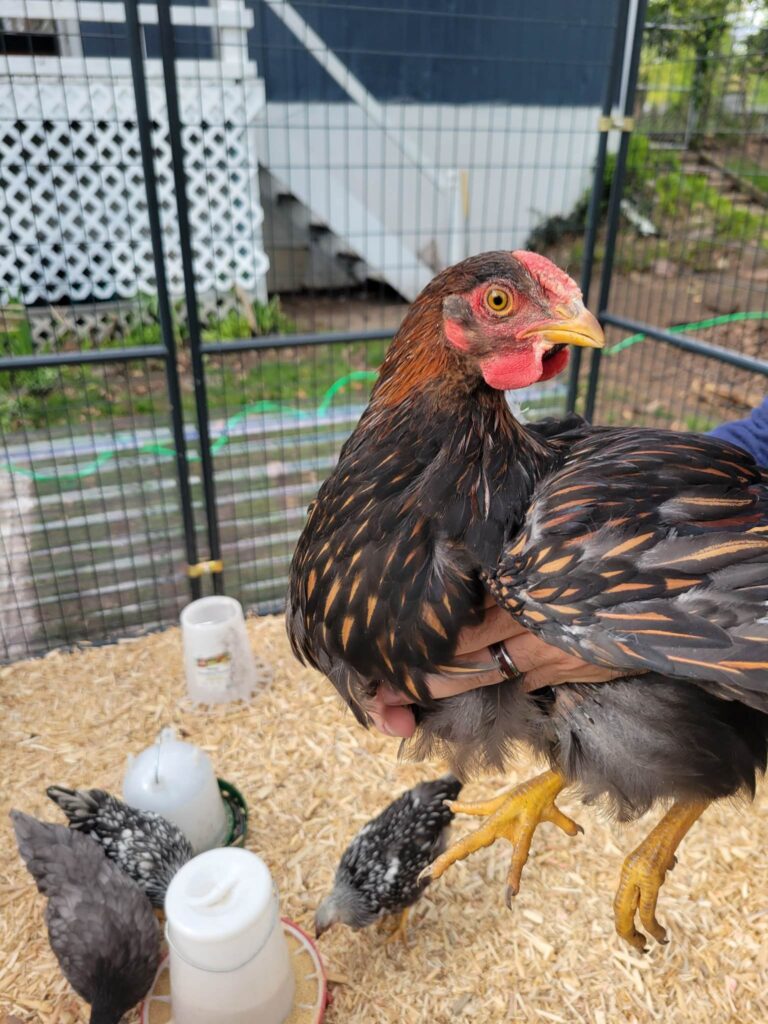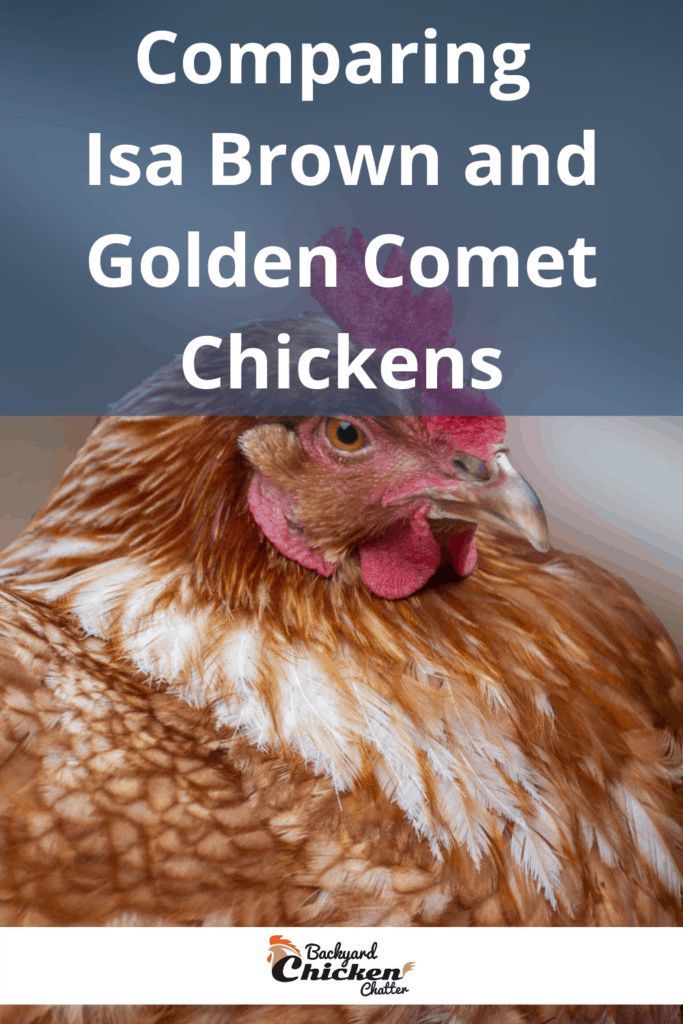A Dominique rooster is a male of the Dominique chicken breed, while a hen is the female. The rooster typically has more pronounced plumage and a larger comb.
Understanding the key differences between a Dominique rooster and a hen is essential for poultry breeders and hobbyists alike. The Dominique breed, known for its barred feather pattern and hardy nature, is one of the oldest chicken breeds in the United States.
The rooster boasts an impressive stance with its vibrant, larger feathers and its comb, which is a sign of sexual maturity and health; it crows to assert territory. On the other side, the Dominique hen has a more subdued appearance and her focus is on egg-laying. Being able to distinguish between the two is crucial for managing a flock’s reproductive dynamics and ensuring the welfare of these birds. With their charming appearance and good temperament, Dominique chickens make an excellent choice for both seasoned farmers and those new to raising backyard poultry.

Credit: www.backyardchickens.com
The Dominique Breed: An American Original
The Dominique chicken commands a legacy as rich as its distinctive plumage. Known for its striking black and white barred feathers, this breed stands as a symbol of American heritage. Often confused with the Barred Plymouth Rock, the Dominique holds its unique spot in the history and hearts of poultry enthusiasts. Let’s delve into the roots and traits that make Dominiques a living piece of American history.
Historical Roots Of The Dominique Chicken
Dominique chickens, boasting a lineage that traces back to early American settlers, hold the title of the oldest American chicken breed. Pioneers favored these birds due to their dual-purpose qualities: they provided both eggs and meat. Structured with a robust genetic foundation, Dominiques were the settlers’ resilient partners, adapting to harsh conditions without wavering in productivity. Documentation reveals their presence at poultry shows as early as the 19th century, where their singular appearance earned widespread admiration.
Physical Characteristics And Breed Standards
Recognized by the American Poultry Association in the late 1800s, Dominiques exhibit a unique pattern termed ‘cuckoo barring.’ This feature distinguishes them from closely related breeds. Breeding standards emphasize a well-proportioned body, a rose comb, and a set of distinctive barred feathers that serve as their trademark.
| Feature | Description |
|---|---|
| Comb Type | Rose comb, suited to colder climates |
| Size | Medium, hens weigh around 5 lbs, roosters approximately 7 lbs |
| Color Pattern | Barred (black and white), with colors alternating in slim, well-defined bands |
| Temperament | Gentle, calm, and known for their hardiness |
| Egg Production | Dependable layers, offering about 230 to 275 brown eggs annually |
The distinctive beauty of Dominique chickens goes beyond their feathers. These birds carry a story of survival, adaptation, and prominence, making them a beloved icon of American poultry breeds. With their personable nature and reliable productivity, it’s no wonder they continue to charm farmers and hobbyists alike.

Credit: chickenexperts.com
Distinguishing Dominique Roosters From Hens
Farmers and poultry enthusiasts often enjoy distinguishing between genders in the Dominique chicken breed. While this may seem tricky at first, certain characteristics can help identify a Dominique rooster from a hen. Recognizing these features ensures proper care and maximizes the productivity of a flock.
Rooster’s Plumage And Size
- Dominique roosters boast an impressive array of feathers with distinctive barred patterns that are bolder and more pronounced than those seen in hens.
- Their tail feathers often curve majestically and are typically longer and darker.
- Roosters stand out with larger bodies and more muscle mass compared to their female counterparts.
- Hens, on the other hand, have softer feather patterns and are generally smaller in size.
Comb And Wattles: Spot The Differences
| Feature | Rooster | Hen |
|---|---|---|
| Comb Size | Larger and more upright | Smaller and may flop to one side |
| Wattles | Bright red and prominent | Less conspicuous and paler |
| Comb Texture | Firm and rigid | Softer and more pliable |
Behavioral Traits: Rooster Vs Hen Dynamics
Rivalries and dominance often define the rooster’s behavior. Dominant roosters may challenge each other for pecking order supremacy.
- Dominique roosters are protectors, often found guarding the flock.
- They also perform courtship dances and vocalize distinct crowing.
- Hens display more maternal instincts, focusing on egg laying and raising chicks.
- They tend to be less confrontational, staying more grounded in their activities.
The Role Of Roosters: Protecting The Flock
In the pecking order of farm life, the domineering rooster stands tall with a role that goes beyond waking up the farm at dawn. Dominique roosters, known for their striking barred plumage and rugged adaptability, take on a vital role. They act as protectors of the flock. Ever vigilant, these feathered sentinels keep a sharp eye on their hens, ensuring their safety from predators and threats.
Crowing And Territory
Roosters crow to declare their territory. This daily ritual sends a message to other roosters and predators. The message is clear – this space is taken. A Dominique rooster uses his powerful crow to communicate with his flock too. He alerts them of danger, rounds them up, and maintains the hierarchy within the group.
- Morning crow signals sunrise
- Consistent crowing maintains order and boundary
- Alerts hens to threats and food sources
Roosters As Flock Guardians
The rooster’s role as a guardian is crucial. With their bold and observant nature, Dominique roosters stand guard, watching for potential trouble. Their first sign of threat triggers an array of alarms and behaviors to shield the hens.
- Visual and vocal signals alert the hens to danger.
- Physical stances and aggressive behavior deter predators.
- Hens are led to safety by their protective roosters.
Dominique roosters prove their worth each day. They not only add beauty to the flock but serve a fundamental role in the survival and prosperity of their group. These roosters embody the essence of natural leadership and guardianship on the farm.
Hens At Work: Egg Production And Motherhood
The Dominique chicken, an American heritage breed, stands out with its striking barred feathers. Not just a pretty face, the Dominique hen serves a vital role on the farm. They excel in laying eggs and raising chicks. Let’s discover the traits that make these birds backyard favorites.
Laying Patterns Of Dominique Hens
Dominique hens are known for their consistent egg-laying capabilities. On average, a healthy Dominique can lay about 4 eggs a week. These medium-sized, brown eggs are not only a staple in many kitchens but also a sign of the hens’ wellbeing. Let’s delve into their laying patterns.
- Age to Start: Hens begin laying at around 5 to 6 months old.
- Peak Laying Years: They lay the most eggs in their first few years.
- Seasonal Changes: Egg production may dip when there’s less daylight.
Broodiness And Rearing Chicks
When it comes to motherhood, Dominique hens may show a strong desire to hatch their eggs, known as broodiness. They can be excellent mothers, nurturing and protecting their chicks with care.
| Broodiness Trait | Rearing Chicks |
|---|---|
| Displays signs like sitting on eggs | Takes care of chicks for several weeks |
| May stop laying to incubate | Teaches foraging and other skills |
Interested chicken owners should provide a safe and comfortable nesting spacefor these broody hens. A secluded area helps the hen focus on the hatching process without stress. It’s important to ensure that both the mother hen and her chicks get the right nutrition to maintain their health during this critical time.
Caring For Dominique Chickens
Embracing the care of Dominique chickens means understanding their needs and creating an environment where they can thrive. Whether you have a robust rooster or a happy hen, proper care is essential. From offering an appropriate habitat to ensuring their diet supports their health, let’s delve into caring for these charming birds.
Habitat Requirements
Dominique chickens require a safe and comfortable home. Here are the essentials:
- Space: Aim for at least 4 square feet per bird inside the coop and 10 square feet in the run.
- Protection: Use hardware cloth to secure the coop from predators.
- Nesting: Provide one nesting box for every 4-5 hens.
- Perches: Ensure enough roosting space, about 8-10 inches per chicken.
- Ventilation: Good airflow prevents respiratory issues and keeps the coop odor-free.
Diet And Nutrition
Dominique chickens flourish on a balanced diet. Here’s how to nourish them:
| Age | Feed Type | Treats (up to 10% of diet) |
|---|---|---|
| 0-6 weeks | Starter Crumbles | Fruits, Veggies |
| 6-20 weeks | Grower Feed | Grains, Greens |
| 20+ weeks | Layer Pellets | Mealworms, Cooked Eggs |
Health And Wellness
Keeping Dominique chickens healthy is crucial. Follow these tips:
- Regular check-ups: Look for signs of illness or stress.
- Parasite control: Treat for lice, mites, and worms routinely.
- Vaccinations: Follow recommended vaccine schedules.
- Cleanliness: Keep the coop clean to prevent disease.
- Stress management: Ensure a peaceful environment to avoid stress.

Credit: fineartamerica.com
The Social Structure Of Chicken Flocks
Chickens live in complex societies known as flocks. These flocks have a clear hierarchy that maintains order and harmony. Understanding this social structure is key, especially when introducing new birds, like Dominique roosters or hens. Observing their interactions sheds light on the importance of their roles and relationships.
Pecking Order ExplainedPecking Order Explained
Each chicken flock operates under a pecking order: a system that determines their rank and standing. Here’s how it works:
- The top chicken, often a rooster, leads the flock.
- Hens follow, with older hens usually ranking higher.
- Younger birds and newcomers fall lower in the hierarchy.
This pecking order plays out in daily activities such as eating, laying eggs, and roosting. Birds higher up get first dibs on food and nest boxes. Those lower down wait their turn.
Integrating Roosters and HensIntegrating Roosters And Hens
Bringing new Dominique roosters or hens into an established flock needs care:
- Quarantine new birds to prevent illness spread.
- Introduce them gradually to allow observation.
- Monitor the flock to mitigate conflicts early on.
Integration can shake up the social order, but with time, new roles emerge, and stability returns. Roosters play a role in protecting the flock, while hens contribute to its growth.
Breeding Dominique Chickens
Dominique chickens stand out with their striking barred plumage and a rich history tracing back to America’s early days. They are a dual-purpose breed, valued for both eggs and meat. Breed enthusiasts prize Dominiques for their hardiness and friendly nature. Breeding these birds not only brings joy but also contributes to preserving a piece of agricultural heritage. The focus on selective mating and genetic preservation enables the ongoing refinement and survival of the breed.
Selective Mating Practices
Selective mating is critical in maintaining the breed’s unique characteristics. Careful selection ensures that the resulting offspring carry the desirable traits of their parents. Breeders often look for key Dominique qualities such as:
- Rose combs to protect against frostbite
- Calm and friendly temperament
- Good foraging ability for efficient feeding
When choosing a rooster and hen for breeding, it is important to consider their health and vitality. Ensuring a diverse gene pool prevents inbreeding, thereby promoting a robust flock.
Genetic Preservation Of The Breed
Conscious efforts to sustain the Dominique breed involve genetic preservation. This involves:
- Documenting bloodlines for traceability.
- Registering with breed clubs to share and gain knowledge.
- Participating in poultry shows for public awareness.
Through these practices, the unique genetic makeup of the Dominique chicken remains intact. This helps prevent the breed from becoming endangered. Breeding programs contribute significantly to the diversification and sustainability of poultry breeds globally.
The Future Of The Dominique Breed
The Future of the Dominique Breed sparks both curiosity and concern among poultry enthusiasts. Known for their distinctive black and white barred plumage and resilient nature, Dominique chickens have trodden a bumpy road towards preservation. As America’s oldest chicken breed, their future teeters on the edge of continued heritage or fading into obscurity. In this section, we’ll dive into two pivotal aspects shaping the destiny of these historic birds.
Conservation Efforts
Concerted conservation efforts are critical to safeguarding the future of the Dominique breed. Organizations like The Livestock Conservancy put Dominiques on their watch list, indicating the need for immediate action to prevent their potential disappearance.
- Genetic preservation projects
- Public awareness campaigns
- Preservation through participation programs
These initiatives encourage breeders to maintain pure lines, keeping the Dominique genetics vibrant and true to their heritage. They also educate future generations on the importance of preserving this breed.
The Role Of Poultry Enthusiasts And Breeders
Poultry enthusiasts and breeders play an indispensable role in the Dominique breed’s survival. By choosing to raise Dominiques, they contribute to maintaining the genetic pool of this heritage breed. Their dedication ensures that the Dominiques continue to grace farms and homesteads with their presence.
| Role | Impact |
|---|---|
| Breeders | Expand and strengthen the gene pool |
| Show Participants | Increase visibility and interest |
| Backyard Poultry Keepers | Contribute to breed numbers and awareness |
Additionally, through showing Dominiques at poultry shows, breeders gain recognition, which in turn sparks interest in others to conserve the breed. Whether in backyards or on small-scale farms, each Dominique rooster and hen plays a part in this collective effort.
Conclusion
Understanding the differences between Dominique roosters and hens can enrich your poultry knowledge. Both possess unique traits critical for breed enthusiasts or backyard farmers. Embrace their heritage and characteristics, and you’ll enhance any coop with these beautiful birds. Ready to choose your Dominique?
Happy farming!
